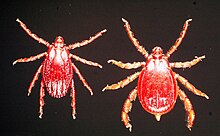Rhipicephalus appendiculatus
| Rhipicephalus appendiculatus | |
|---|---|
 | |
| Female (left) and male (right) | |
 | |
| R. appendiculatus in the ear of a calf | |
| Scientific classification | |
| Domain: | Eukaryota |
| Kingdom: | Animalia |
| Phylum: | Arthropoda |
| Subphylum: | Chelicerata |
| Class: | Arachnida |
| Order: | Ixodida |
| Family: | Ixodidae |
| Genus: | Rhipicephalus |
| Species: | R. appendiculatus |
| Binomial name | |
| Rhipicephalus appendiculatus Neumann, 1901 | |
Rhipicephalus appendiculatus, the brown ear tick,[1] is a hard tick[2] found in Africa where it spreads the parasite Theileria parva, the cause of East Coast fever in cattle.[3] The tick has a three-host life-cycle, spending around 10% of its life feeding on animals.[2] The most common host species include buffalo, cattle, and large antelope,[2] but R. appendiculatus is also found on other animals, such as hares, dogs, and warthogs.[4]
Rhipicephalus appendiculatus is found in the center, east and south-east of Africa,[4] in areas with at least 24 in (610 mm) of rainfall each year.[2]
R. appendiculatus is 1.8 to 4.4 mm (0.071 to 0.173 in) long, and is a dark reddish-brown or brown color.[1]
The sex pheromone used by female ticks to attract males for mating consists of two chemicals; phenol and p-cresol.[5]
References
- ^ a b Taylor, M.A.; Coop, R.L.; Wall, R.L. (2016). "Rhipicephalus appendiculatus (brown ear tick)". Veterinary Parasitology (4th ed.). John Wiley & Sons. p. 249. ISBN 9780470671627.
- ^ a b c d "Rhipicephalus appendiculatus" (PDF). The Center for Food Security & Public Health, Iowa State University. September 2009. Retrieved 2018-05-06.
- ^ "Protecting Africa's cattle with a live vaccine: An East Coast fever impact narrative". ILRI Research Brief. No. 24. International Livestock Research Institute. September 2014. Retrieved 2018-05-06.
- ^ a b Walker, Jane B.; Keirans, James E.; Horak, Ivan G. (2005). "Chapter 7. Accounts of individual species occurring in the Afrotropical region. Rhipicephalus appendiculatus Neumann 1901". The Genus Rhipicephalus (Acari, Ixodidae): A Guide to the Brown Ticks of the World. Cambridge University Press. pp. 59–71. ISBN 9781316583746.
- ^ Wood, William F.; Leahy, Mary G..; Galun, R.; Prestwich, G. D.; Meinwald, J.; Purnell, R. E.; Payne, J. (1975). "Phenols as Sex Pheromones of Ixodid Ticks: A General Phenomen?". J. Chemical Ecology. 1: 501–509. doi:10.1007/BF00988590.










